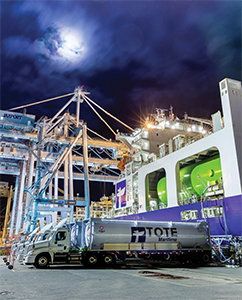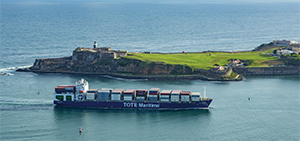In the past few years, liquefied natural gas (LNG) has made steady headway in the United States as a marine fuel. But while operators have moved ahead with training for mariners on these vessels, the U.S. regulatory framework remains a work in progress.
The International Maritime Organization (IMO) has adopted rules requiring specific LNG training. Mariners must demonstrate certain competencies and familiarization with LNG vessels to meet the standards, which took effect on Jan. 1.
Since 2015, American operators have followed a U.S. Coast Guard policy letter that closely mirrors international protocols. The service is currently adapting these standards into formal regulations. In the meantime, the Coast Guard’s National Maritime Center is not yet approving LNG training courses, or issuing endorsements for mariners who complete them.
Bob Kamb, manager of LNG services with ABS Group, a technical advisory firm and subsidiary of the American Bureau of Shipping, said the Coast Guard’s policy letter clearly states which competencies are required. But the lack of an endorsement or certifications for the training programs has created “a gray area in regard to training.”
“We can easily comply with the spirit of the regulations, but it may be more challenging to comply with the letter of the regulations,” Kamb said. “We can navigate it because we have the policy letter and can anticipate what the requirements (will be) once the regulations are released.”
Harvey Gulf made history in early 2015 when it took delivery of Harvey Energy, the first LNG-fueled offshore supply vessel. The company now operates three such vessels and three more are in the works. Also in 2015, TOTE Maritime’s 764-foot Isla Bella became the world’s first LNG-powered containership. TOTE has since taken delivery of a second LNG containership, Perla del Caribe.
Those early adopters will soon have some company. El Coqui, Crowley’s first LNG-fueled con-ro ship, is expected by mid-2017, and American Petroleum Tankers, Crowley and SEA-Vista have taken delivery of LNG-ready tankers. Washington State Ferries is exploring LNG conversion for one of its ferries.
“LNG is definitely on our radar screen,” said Washington State Ferries spokesman Ian Sterling.
Regulatory, economic and environmental factors that benefit LNG are probably here to stay. LNG costs less and burns cleaner than marine diesel, thereby reducing operating expenses while meeting potentially stricter emissions rules in the future. LNG also is appealing to companies looking to reduce their carbon footprint.
“Certainly the regulatory environment we are moving into under IMO is a driver,” said TOTE Executive Vice President Peter Keller. “But … the world in general is being much more cognizant of the environment. That is the world we live in, and that is what we commonly call today corporate social responsibility.”
Although diesel prices have come down in recent years with the cost of oil, LNG prices have fallen as well, although in most cases not as much. With oil at $50 a barrel, Keller believes LNG is not necessarily as favorable. “But when oil is $60 or $70 a barrel,” he said, “LNG is very favorable.”
There has been steady progress of late with LNG bunkering facilities, eliminating a hurdle to wider adoption of the fuel. The first LNG marine fueling facility in North America opened in early 2016 in Port Fourchon, La., to serve Harvey Gulf’s vessels. LNG terminals under construction in the Jacksonville, Fla., area will fuel TOTE and Crowley ships. Currently, TOTE’s vessels are bunkered by truck.
“If society develops the infrastructure to support it, then LNG certainly has the strong potential to be a maritime fuel in the future for many types of vessels,” said Cmdr. Jason Smith, detachment chief for the Coast Guard’s Liquefied Gas Carrier National Center of Expertise in Port Arthur, Texas.
If that happens, more mariners will need the training required to work aboard these vessels. Yet the U.S. regulatory and training framework is still an area of uncertainty.
 |
|
Conrad Industries is building an LNG bunkering barge for TOTE to fuel its dual-fuel ships in Jacksonville, Fla. Until then, Isla Bella and sister ship Perla del Caribe are bunkered by truck. |
|
Courtesy TOTE Maritime |
The IMO has incorporated key aspects from the International Code of Safety for Ships using Gases or other Low-flashpoint Fuels, or IGF Code, into its Standards of Training, Certification and Watchkeeping (STCW). Those rules, which took effect on Jan. 1, set baseline competency requirements for crewmembers working on LNG-fueled vessels. Certain crewmembers must spend a month working on board an LNG vessel and participate in three bunker transfers, although two such operations can be conducted on a simulator.
The Coast Guard’s 2015 policy letter closely follows these standards. The 22-page document describes two types of training required for mariners working on these vessels. Crews with limited involvement in bunkering or vessel operations must complete a basic training course focusing on health and safety, hazard and pollution prevention, firefighting and emergency preparedness. Vessel masters, engineering officers and crew directly involved in bunkering must complete advanced training.
“The people who are taking the basic level are people who need the familiarization and awareness level for supporting the actual operation,” said Capt. Jerry Pannell of the STAR Center, which has trained TOTE and Crowley crews. “The advanced level is specifically for those individuals actively involved in the use of LNG as a fuel. It includes bunkering operations and actual fuel-to-engine operations that go along with that.”
Both the basic and advanced programs include an introduction to LNG and its properties. For instance, LNG is formed when natural gas is cooled to minus 259 degrees Fahrenheit, and as a liquid it is not explosive. “LNG vapor will only explode if in an enclosed space. LNG vapor is only explosive if within the flammable range of 5 to 15 percent when mixed with air,” according to the California Energy Commission.
Tom Guldner, president of Marine Firefighting Inc., said existing training highlights differences between bunkering LNG versus marine diesel. LNG is “a gaseous product that can have flammable zones near the refueling areas,” said Guldner, who has led LNG firefighting training programs for 17 years. “It’s also a cryogenic and any contact with the liquid can destroy the metal of a (ship) deck and can also destroy human tissue.”
Firefighting on LNG vessels requires different tactics. Foam is a key extinguishing agent for fires aboard conventionally-fueled ships, but with LNG, crews should typically avoid fighting the fire if possible. When it is necessary, water spray and foam can be used to disperse an LNG cloud.
“If you can let the gas burn off, that is the safest way to handle it,” Guldner said.
There are a handful of training centers and organizations offering LNG training. In addition to the STAR Center, the United States Maritime Resource Center (USMRC) in Middletown, R.I., developed a course for Harvey Gulf’s crews. The Coast Guard reviews these courses to ensure they conform to the U.S. and international guidelines but does not formally approve them. The service will not do so until its regulations are finalized. Mariners who complete training offered by these facilities receive documentation they can show the Coast Guard.
Training academies have managed this unusual scenario by tailoring LNG courses to the Coast Guard’s policy letter and the IGF standards adopted by the IMO. “There are courses out there and the Coast Guard is recognizing the courses on a case-by-case basis. They are working to make sure they meet the Coast Guard policy letter in place for LNG as a fuel,” Smith said.
“What this means is, companies have to use courses that are not quite yet approved, and the Coast Guard marine inspectors when they inspect vessels have to do a little more research — what courses mariners used, how does it meet the requirements and how does it meet the policy letter,” he continued. “This puts a little more of a burden on the marine inspector and the industry to show how they meet the requirements.”
The U.S. fleet of LNG vessels is still small, and consequently so is the marketing for training these crews. The STAR Center, for instance, has trained about 100 mariners and first responders.
This type of training also is a relatively new part of the maritime instruction mix. For that reason, TOTE and Harvey Gulf have worked closely with the Coast Guard and their respective training partners to make sure the programs passed muster.
Kamb of ABS Group expects the market for LNG training to grow over time, particularly as more operators see the successful use of the fuel. Rising oil prices or new emissions rules could be another big driver. He expects the Coast Guard to issue its final regulations in due time, and said the service has done what it can to simplify an uncertain process.
“It’s quite clear what needs to be done, and the industry understands what needs to be done,” Kamb said. “It’s meeting the letter of the law, and the letter of the regulations, that is still a little challenging.”

